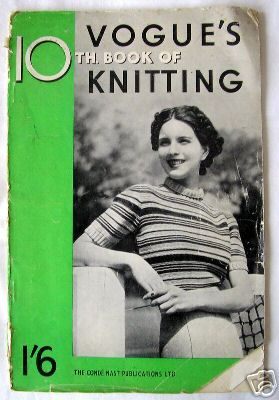I got all five of those VKB’s on eBay yesterday – not surprising, with what I bid. It was an expensive afternoon. Some of my competitors are old friends (so to speak) by now, but a new one popped up yesterday and was the underbidder on four of the five, outbidding everybody but me by quite a lot. I hope s/he goes away before any more turn up.
I’ve now got all the postwar ones except Autumn ’46 and Autumn ’53. I still lack nine of the wartime ones, and 12 from the 30’s.
Here is my prize of yesterday, Spring ’37. I’ll tell you all about it when it arrives.

Kitchener Stitch
This is the crucial sentence Jayne sent me from the Toronto Globe and Mail of January 17, 1918 –when the Great War still had nearly a year to run:
“A good knitter can speed up to 60 stitches a minute, but what with purling and seaming and Kitchener-toeing, she could not average more than 30 to 40 stitches a minute…”
(It is interesting, history-of-language-wise, how the writer uses “Kitchener-toe” as a verb, just as we often nowadays speak of “kitchener’ing” something. The reference to “seaming” is interesting, too. If that’s how socks were knit in those days, it’s no wonder the “Kitchener toe” caught on, as more comfortable.)
I wrote to Kim Salazar, who responded promptly, and remembered that she and I had corresponded in the past on this interesting subject, but didn’t seem as stunned as I am by the early date of this quotation. I wrote to both the Canadian and British Red Cross’s. London has replied, saying that I will have a proper answer within two or three weeks. Silence so far from Ottawa.
My hope is that London might have a copy of the Canadian leaflet in their archives. The leaflet, indeed, might have been published in Britain as well as Canada. (By now, I have virtually no doubt that there was such a leaflet.) My theory is that the technique of grafting knitting was, at that date, better known in Britain than in North America. Possibly, not known in North America at all. And that’s why North American knitters (and, until recently, they alone) refer to “Kitchener stitch” – the new idea spread fast, as everybody knitted socks for soldiers.
(I have a Paton’s Family Knitting Book of 1904 or some such year in which sock toes are grafted – so the technique was known here, and Lord Kitchener didn’t have to work it out for himself.)
It is easy for us to forget in this brave new world of instant world-wide communication, how isolated we were from each other, how recently. There weren’t many knitting books – and no camps! -- in the early years of the 20th century. Skills would have been passed from knitter to knitter largely by word of mouth. Grafting is not obvious, by any reckoning.
Comments
I’m running out of space. Ron, welcome aboard. I’m glad Mexico isn’t too hot for knitting altogether. I have more to say and show about Fair Isle in which the colour sequence doesn’t fit the stitch sequence, but it will have to wait until tomorrow. Mundi, yes, that’s the designer I mean. I didn’t name her in order to prevent a Google search on her name winding up here. I thought it might verge on the libellous to have identified the source of her design. She gives no credit to Odham’s Encyclopedia of Knitting in her published pattern. (See my blog entries for the last couple of days, to find out what we’re talking about.)




No comments:
Post a Comment